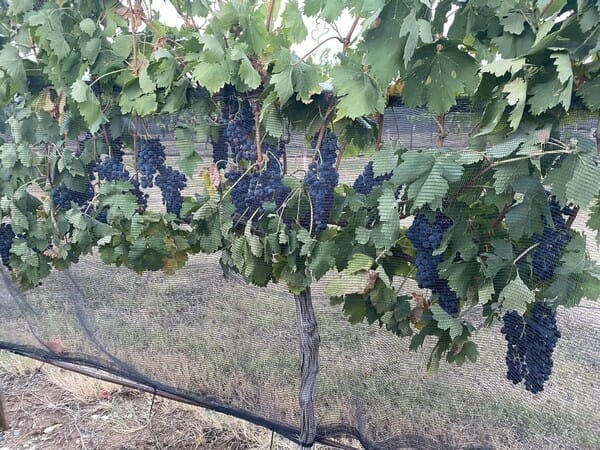


Tempranillo growing in Texas
This article comes to us from Spain, the country where the Tempranillo grape was born.
Our colleagues at Winetourismspain.com share with us why Tempranillo is considered the most important red grape variety in Spain; its greatest strengths, its few shortcomings, and a few stories that help us here in Texas connect with this grape that, in many ways, has also become our own.
Behind every sip of Tempranillo lies a long, rich, and—as its flavor suggests—intense history. For those who grow it today in Texas, understanding where Tempranillo comes from helps us celebrate it and better understand where it’s headed, on a path increasingly shared with wine regions across the world.
Although today Tempranillo thrives in places like California, Argentina, Australia, and of course, Texas, it remains, without a doubt, a deeply Spanish creation. Most famously nurtured along the winding banks of the Ebro River—especially in La Rioja and Navarra—this variety has, for centuries, been the backbone of Spain’s greatest red wines.
As with many grapes of ancient lineage, the precise origins of Tempranillo are cloaked in legend, dusty documents, and botanical theories. Some believe it’s a mutation of a grape brought to the Iberian Peninsula by French monks via the Camino de Santiago. Others are convinced it’s a true native of the Ebro basin, perhaps cultivated as far back as the Phoenician era. What we do know is that the first written reference dates back to 1513, in Alonso de Herrera’s Treatise on General Agriculture, where he refers to the variety as “Aragonés,” describing it as a vine with large, tightly packed clusters and thick-skinned berries that yield a deep, dark wine—not particularly long-lived, he adds, unless blended with white varieties. The irony, of course, is that today many of Spain’s finest and most age-worthy wines are made almost entirely from Tempranillo.
But what exactly makes this grape so special? And why has it been so successful? The name itself gives us a hint. “Tempranillo” comes from temprano, or “early,” referring to its relatively short ripening cycle compared to other red grapes. It’s among the first to be harvested each year—a fact well known to winegrowers. In Rioja, for example, Tempranillo harvest can begin as early as the first days of October, long before varieties like Garnacha, Mazuelo, or Graciano are ready. This early ripening is a huge advantage. Farmers dread hailstorms and unpredictable weather near harvest time. When grapes are nearing ripeness, the wait can feel like forever. Every extra day adds risk, so there are few things more appreciated in the vineyard than a grape that ripens early and still delivers exceptional results. Many people who enjoy wine tours in Spain and in Rioja in particular, find it frustrating to get to wine country a bit late and find the harvest is already gone.
Agronomically, Tempranillo is tailor-made for Spain’s latitude. It thrives under very specific conditions: plenty of sunshine during the day, cold nighttime temperatures, and moderately high altitudes. It doesn’t tolerate extreme heat or prolonged drought particularly well, which makes growing it outside Spain a delicate balancing act. Yet parts of the Texas Hill Country and High Plains have proven surprisingly suitable—cool nights and well-drained soils have made not only cultivation possible, but also the production of wines with real character.
The grape itself is a thick-skinned, blackish-blue variety. Its natural acidity tends to be low—a technical challenge—but its silky texture and aromatic complexity more than make up for it. Tempranillo is incredibly versatile: from crisp rosés to vibrant young reds, and all the way to age-worthy, oak-aged masterpieces.
Today, Tempranillo accounts for about 80% of all vineyards in Rioja. But its influence stretches far beyond that. It’s authorized in 28 of Spain’s denominaciones de origen (DOs) and is considered a primary variety in 12 of them. It also has a chameleon-like personality, adapting to different regions and identities: it’s called Cencibel in Castilla-La Mancha, Tinto Fino in Ribera del Duero, Tinta de Toro in Zamora, Ull de Llebre in Catalonia, and Aragonez or Tinta Roriz in Portugal. In California, it’s even referred to as Valdepeñas. It’s as if this grape doesn’t just carry a story—it carries multiple passports.
Interestingly, in 1988, a natural genetic mutation gave rise to a white version of the grape: Tempranillo Blanco. Discovered in an old vineyard in Murillo del Río Leza, in La Rioja, this rare gem retains much of its red cousin’s aromatic elegance, but with higher acidity and a fruit-forward profile that makes it ideal for fresh, well-balanced white wines.
But let’s return to its homeland, where Tempranillo is more than dominant—it’s emblematic. The phrase “Tempranillo is Rioja, and Rioja is Tempranillo” is no exaggeration. This grape has shaped the style and reputation of the region for generations. Compared to Garnacha—which brings sweetness and jammy, fruit-forward notes—Tempranillo stands out for its elegance, structure, and balance. It has firmer tannins, a higher pH, and a natural affinity for aging in oak, where it develops complex notes of vanilla, leather, tobacco, and spice.
Decades ago, many winemakers chose to favor Tempranillo over Garnacha, and not without reason. Think of a time before modern temperature control in wineries—when Garnacha’s tendency to oxidize could easily ruin a batch. Tempranillo, which ripens earlier, allowed winemakers to bring in their grapes before the riskiest weather and ferment them with fewer oxidative concerns. Quality and practicality aligned—Tempranillo was the obvious choice.
If we need a third reason to complete the triangle of its success, it would be versatility. This grape can deliver anything from delicate rosés to bold reds, and everything in between—including long-lived wines that evolve beautifully over time.
That’s why it makes so much sense that Texas has become a welcoming home for Tempranillo. For years now, Texas winemakers have seen in this grape a variety that can adapt to the local climate without sacrificing quality. And Tempranillo has responded—strongly. Not only does its short growing cycle suit regions where summer heat arrives fast, but it also has an amazing ability to reflect the terroir. Just as Tempranillo from Rioja is subtle and aromatic, and from Ribera del Duero is bold and dark, and from Toro is wild and intense, in Texas it has found a new voice—fresh, honest, and full of personality.
This grape, once carried along the ancient paths of the Camino de Santiago, now puts down roots in the red soils of the Hill Country, promising to keep evolving.
Grapes, shaped by soil, climate, and the hands of growers and winemakers, give life to wines that stay with us through meals and conversations. Wines bear witness to the stories we tell at the table—and they tell stories of their own. From Spain to Texas, the journey of Tempranillo has already told many tales. And there are still so many more to come.
Maybe, as you sip a glass of Texan Tempranillo while reading this, you’ll sense a hint of what we feel in Rioja. Or maybe you won’t, and if you don´t consider visiting and enjoying a wine tour there. On our end, from Spain, I can’t help but feel curious about what a Tempranillo grown under the Texas sun tastes like. It’s a beautiful thought—that the same grape can tell different stories, yet bring us closer together.





